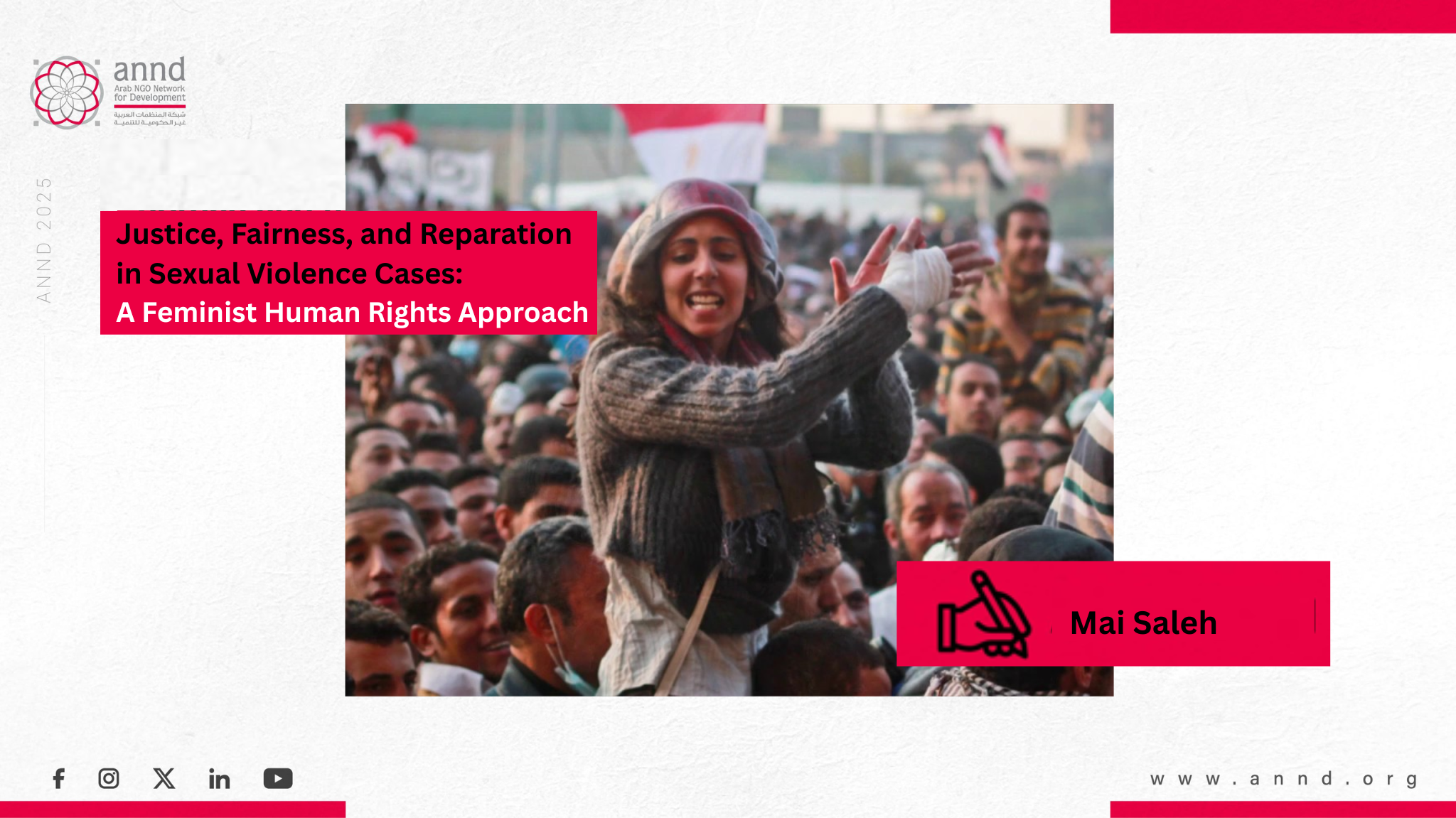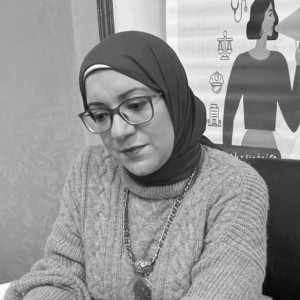Justice, Fairness, and Reparation in Sexual Violence Cases: A Feminist Human Rights Approach – Mai Saleh
Introduction
Sexual violence is one of the most severe forms of gender-based violence violating human rights and undermining the dignity of women and girls. Its impact is not limited to physical and psychological harm, but extends to excluding victims from public life and reinforcing inequality and discrimination.
With technological advancement and the widespread use of the internet and social media, a new form of sexual violence has emerged, known as digital violence, which expands the scope of violation beyond the body into the virtual space. It magnifies the consequences of this violence on the victim by targeting her symbolic body, social image, and personal space. Due to social stigma, victims may not receive the necessary family support; instead, the family itself may become a source of pressure or punishment out of fear of “shame and consequences.”
Despite international recognition of sexual violence as a serious crime in both conflict and peace settings, national justice systems still suffer shortcomings in ensuring fairness and reparation for survivors. Practical realities reveal a significant gap between legal texts and implementation. The main challenges include limited evidence, social stigma, cultural barriers, and the shortcomings of national legislation in defining sexual violence or specifying evidentiary procedures. Many judicial systems also lack qualified personnel to deal with victims, leading to diminished trust of survivors in the legal system.
These challenges render justice in sexual violence cases incomplete, making the pursuit of justice in these cases a complex process involving legal, cultural, and institutional dimensions. Justice in sexual violence cases goes beyond prosecuting perpetrators; it is a comprehensive system that acknowledges harm, ensures accountability, and provides survivors with a path toward healing and dignity. This underscores the need for a transformative approach that rethinks the structure of justice itself and adopts a feminist, survivor-centered framework.
First: The Conceptual Framework of Justice in Sexual Violence Cases
Justice refers to an integrated system of rules and procedures that ensure fair treatment of both the victim and the accused. Justice begins from the moment the crime is reported, through investigation and trial, and up to issuing and enforcing the verdict. However, realities reveal major gaps in achieving justice, as victims often face a culture of victim-blaming, social stigma, and legal challenges related to evidence.
Gender-sensitive justice takes into account the structural inequalities between men and women in accessing justice and designs its mechanisms to respond to the needs of survivors of violence. It is not limited to punishing offenders but seeks to reform legal and social systems that reproduce violence and discrimination. In this context, justice goes beyond “punishment” to include all procedures that ensure:
- Recognition of victims’ rights and respect for their dignity during investigation and trial.
- Accountability for criminal acts without discrimination or cultural justification.
- Effective protection from threats or retaliation during and after judicial proceedings.
Second: Fairness as a Moral and Legal Dimension
Fairness (Equity) is a complementary concept to justice, requiring the removal of structural and discriminatory obstacles that prevent women from enjoying their rights equally. It means considering the differences and specific circumstances of each case individually. In sexual violence cases, traditional criteria alone cannot be used to assess harm. Contemporary legal scholarship stresses that fairness requires acknowledging the unequal power relations between the perpetrator and the victim, especially in cases of authority-based relationships such as workplace dynamics, and factors like social context, awareness level, or ability to resist.
Fairness requires going beyond procedural rigidity to understanding the psychological and social impact of the crime. It means giving the survivor a real opportunity to regain her status and dignity through:
- Access to justice without discrimination or fear of stigma or retaliation.
- Fair and swift procedures that do not re-traumatize the survivor through humiliating questions or examinations.
- Providing psychological and social support that helps her heal and re-enter public life.
Third: Reparation as Part of Transformative Justice
Reparation is one of the pillars of transitional and transformative justice and is defined as a set of measures taken to address harms resulting from gross human rights violations. The UN Special Rapporteur on Reparation has identified five essential forms of reparation:
- Recognition and official apology.
- Material and moral compensation proportionate to the extent of physical, psychological, and social harm.
- Rehabilitation and psychological/social support.
- Restoring rights and reintegration.
- Guarantees of non-repetition through institutional and legislative reforms.
Reparation is therefore viewed as a cornerstone of transformative justice, which not only eliminates individual harm but seeks to change the social and cultural structures that allow sexual violence to occur and persist.
Toward Comprehensive Transformative Justice
Transformative justice goes beyond individual accountability to rebuilding community trust and changing power relations that enable ongoing violence. It addresses the cultural roots of violence and dismantles patriarchal power structures. Its core principles include:
- The participation of survivors in designing and implementing reparation and reform programs.
- Integrating psychological and social support within the justice system.
- Strengthening protection institutions, equal-opportunity units, and legal aid services.
- Reforming legislative, security, and judicial institutions to ensure protection and accountability.
- Adopting public policies based on equality and socio-economic empowerment of women.
The international human rights system has established several frameworks obligating states to protect women from violence and ensure fairness, most notably:
- The Convention on the Elimination of All Forms of Discrimination against Women (CEDAW).
- The UN Declaration on the Elimination of Violence against Women (1993).
- The UN Basic Principles on the Right to Remedy and Reparation (2005).
- UN Security Council Resolution 1325 (2000) and related resolutions on Women, Peace, and Security.
- ILO Convention 190 on Violence and Harassment in the World of Work and its accompanying Recommendation 206 (2019).
At the heart of this landscape, feminist movements—since the early 20th century until today—have played a crucial role in pushing for the development of a justice system responsive to the specificity of these violations and ensuring fairness for victims/survivors. Their role has moved beyond protest to developing knowledge-based, legislative, and institutional tools that now form the foundation of any just reform, including:
- Redefining sexual violence as a public issue, not a private one.
- Building psychological and social support systems for survivors.
- Developing tools for advocacy, defense, and digital documentation.
- Pressuring for gender-sensitive legislation addressing additional forms of sexual violence such as marital rape.
Conclusion
Achieving justice, fairness, and reparation in sexual violence cases requires a comprehensive vision that goes beyond a narrow legal approach to include reforming the cultural, social, and institutional structures that produce and reproduce violence.
True justice is that which restores dignity to survivors, gives them the opportunity to heal and participate in public life without fear or stigma, and transforms society from a place of silence and denial to one of recognition and responsibility.
This also requires a radical shift in social discourse, which often blames women. Achieving the desired justice becomes a foundation for building a society that respects human rights, guarantees dignity, and confronts structural violence against women. Reparation thus becomes not the end of the justice process, but its beginning toward a more equal, fair, and humane society.
References
- United Nations (1993). Declaration on the Elimination of Violence against Women.
- United Nations (2005). Basic Principles and Guidelines on the Right to a Remedy and Reparation.
- CEDAW Committee (1992). General Recommendation No. 19 on Violence against Women.
- Rubio-Marín, R. (2009). The Gender of Reparations: Unsettling Sexual Hierarchies while Redressing Human Rights Violations. Cambridge University Press.
- Duggan, C. & Abusharaf, R. (2012). Transitional Justice and Gender: A Feminist Perspective. Routledge.
- Clark, J. (2016). Legal responses to sexual violence. Oxford University Press.
- Daly, K. (2006). Restorative justice and sexual assault. British Journal of Criminology, 46(2), 334–356.
- Kelly, L. (2010). The social context of sexual violence. International Journal of Sociology, 28(3), 73–90.
- Rome Statute of the International Criminal Court (1998).
- UN OHCHR (2008). Rule-of-law tools for post-conflict states: Reparations programs.
- UN Women (2015). Framework for prevention of violence against women.
- World Health Organization (2012). Responding to intimate partner violence and sexual violence.



